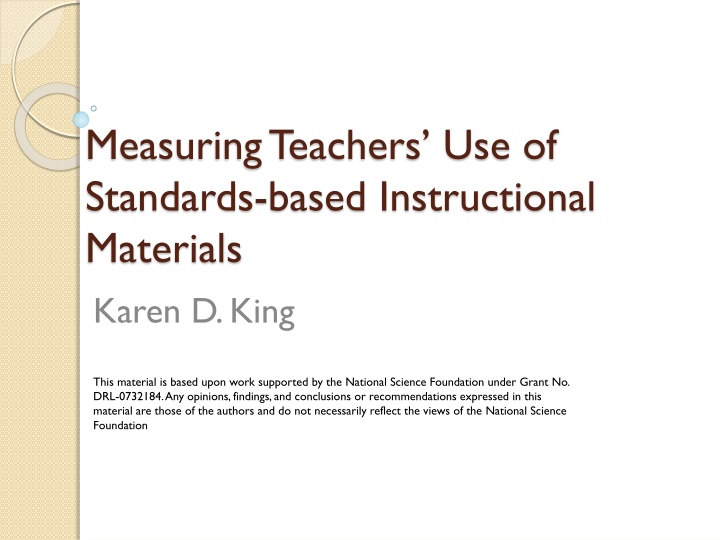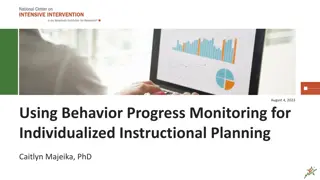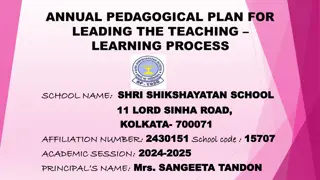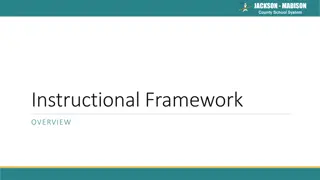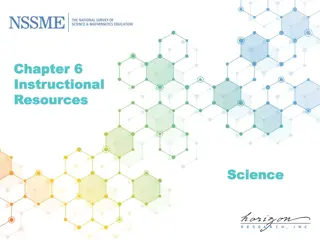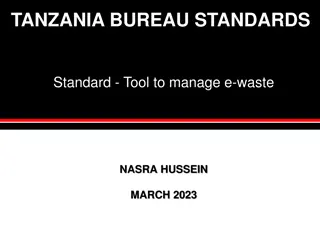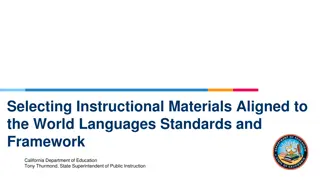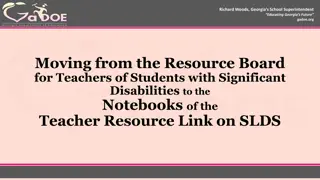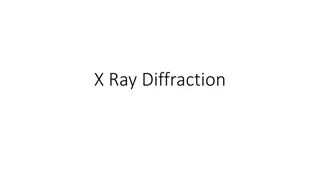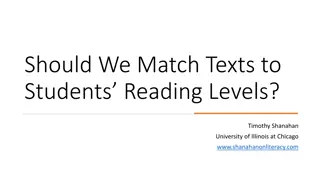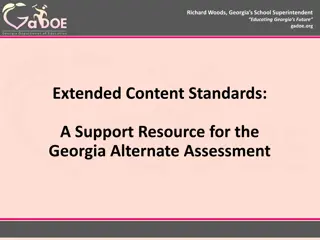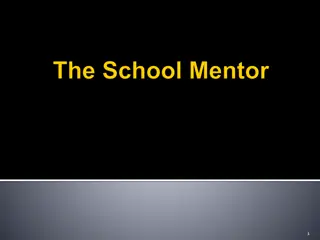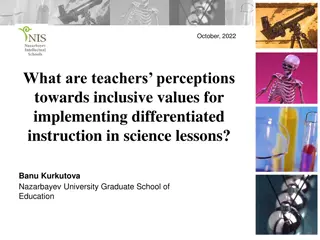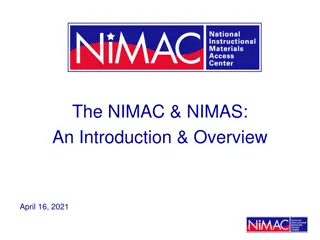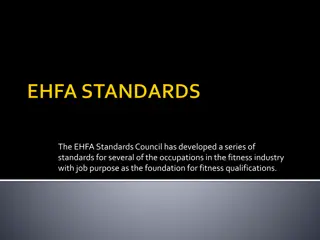Measuring Teachers' Use of Standards-based Instructional Materials
Framing the problem of measuring teachers' use of instructional materials, exploring the distinction between instructional materials and curriculum, and discussing the importance of alignment with various educational policies and standards. The perspective on measuring implementation is also highlighted through the consideration of alignment with curriculum and state standards.
Download Presentation

Please find below an Image/Link to download the presentation.
The content on the website is provided AS IS for your information and personal use only. It may not be sold, licensed, or shared on other websites without obtaining consent from the author.If you encounter any issues during the download, it is possible that the publisher has removed the file from their server.
You are allowed to download the files provided on this website for personal or commercial use, subject to the condition that they are used lawfully. All files are the property of their respective owners.
The content on the website is provided AS IS for your information and personal use only. It may not be sold, licensed, or shared on other websites without obtaining consent from the author.
E N D
Presentation Transcript
Measuring Teachers Use of Standards-based Instructional Materials Karen D. King This material is based upon work supported by the National Science Foundation under Grant No. DRL-0732184. Any opinions, findings, and conclusions or recommendations expressed in this material are those of the authors and do not necessarily reflect the views of the National Science Foundation
Overview Our framing of the problem - measuring textbook use Research question Data collection Results Interpretation Implications for practice and future research Other areas of research
Instructional Materials vs. Curriculum Instructional materials are not curriculum Curriculum is a plan or pathway envisioned from students' current understanding to target understandings as outlined in Standards Instructional materials are tools and resources comprised of a series of instructional tasks and exposition teachers can use to teach the curriculum Often, without curriculum guidance, the textbook/instructional materials become the curriculum, substituting instructional materials designers' goals and plans for that of the district or teacher
Why does this distinction matter? A major concern in implementation is alignment with often conflicting policies State Standards District Curriculum District/School Textbook/Instructional Materials Adoption State Assessments
Our Perspective on Measuring Implementation Considers the alignment of textbook to curriculum (Mitchell, King & Gearhardt, in revision) Considers alignment of curriculum to state standards (Mitchell, et al., in revision; Porter, 2002) Considers alignment of textbook, curriculum, and state standards to state achievement tests (King, et al., in revision)
An Example Fig 3. Grade 8 Cognitive Demand 0.00 0.20 0.40 0.60 0.80 Memorize/Recall Perform Procedures Demonstrate Understanding Conjecture, Generalize, Prove Solve non-routine problems/ Make Connections NJ Stnds 2009 Gr. 8 CMP2 All Units Gr.8
Research Question What is the relationship between middle grades mathematics teachers' use and adaptation of Standards- based instructional materials and students' achievement?
Research Setting Newark, NJ in 2008-2009 school year Had adopted Connected Mathematics Project (CMP) in 2002, started using CMP 2 in 2008-2009 Had an NSF-funded Local Systemic Change project that provided substantial professional development on CMP and middle grades mathematics education through 2008
Data Collection Part of a larger mixed methods study Surveyed 159 middle grades mathematics teachers and the student achievement data from 2528 of their students in their first mathematics class of the week In Spring 2009, teachers completed the Surveys of Enacted Curriculum Instructional Content and Instructional Practices surveys and project- developed CMP Students took the NJ ASK during Spring 2009
Surveys of Enacted Curriculum Demographic information on the teacher, teacher qualifications, and professional development experiences Information on the teachers instructional practices Information on the content and cognitive demand of the instruction To ensure accurate responses, we conducted a professional development session on assessing the cognitive demand of tasks for students prior to teachers completing the survey
SEC Instructional Content Survey Time on Topic For 188 content areas ranging from number to advanced algebra, the SEC-IC asks what proportion of time is spent teaching the topic Emphasis For each content area that the teacher indicates he or she teaches, the SEC-IC asks what proportion of time spent teaching the topic was spent at 5 levels of cognitive demand Memorize facts, perform procedures, demonstrate understanding, conjecture/generalize/prove, solve non- routine problems/make connections Prior to survey administration, teachers participated in professional development to ensure that the meanings for each was established and common
CMP Implementation Survey Background information on teachers experiences with CMP General questions about the teachers use of other materials and context of teaching For each lesson organized by units, we asked teachers to describe their use of each lesson in the textbook with the following instruction:
To answer the following questions, use the following definitions of textbook use Use without modification Follows the outline of the lesson as described in the teachers materials. No changes are made to the task and the structure of the lesson follows the Launch, Explore, Summarize routine described in the CMP materials. The goals and objectives of the lesson remain the same. Use with adaptation Follows the outline of the lesson as described in the teachers materials with changes made to the task, but not the structure of the lesson. The goals and objectives of the lesson remain the same. The structure of the lesson follows the Launch, Explore, Summarize routine described in the CMP materials, but the task is modified in one of several ways Use as a one of many resources Takes tasks from the materials but uses them to create own lesson with own lesson structure. Replace Does not use the materials but takes tasks or lessons from other materials to teach the goals and objectives of the lesson. Does not use Does not use any materials to teach the goals and objectives of the lesson.
Alignment of NJ ASK to New Jersey Mathematics Standards and Instructional Materials NJASK 2009 State Mathematics Standards Connected Mathematics 2 Instructional Materials Grade 6 Grade 7 Grade 8 .21* .26 .25 .29 .30 .30 Alignment considers both the content and cognitive demand alignment (see Porter, et al., 2008)
Data Analysis Includes 143 teachers and their 2107 students Removes teachers we did not have information on: their position type (general or special education), teachers whose classrooms were comprised of very mobile students students for whom we did not have 2008 math scores About 1/3 of teachers in the sample were special education teachers
Measure construction To measure use of the materials, we created the curriculum coverage index (CCI) and to measure adaptation, we created the lesson modification index (LMI). CCI is a simple proportion of the CMP lessons that were not taught during the year LMI represents the extent to which the teacher has modified the lesson, expressed on a three-point scale where the low score represents all lessons as used without adaptation and the high score represents all lessons used as one of many resources.
Measure Construction The SEC creates cognitive demand measures that sum to 1 based on emphasis of each of the types of cognitive demand Memorize facts, perform procedures, demonstrate understanding, conjecture/generalize/prove, solve non- routine problems/make connections Using factor analysis on these SEC measures, we created a new cognitive demand measure which is characterized by stressing "procedures" and avoiding "non-routine problems"
Results: Incomplete table ofHLM Fixed Effects Estimates for a Model of 2009 NJ ASK Mathematics Scale Score with Robust Errors Fixed Effect Model Intercept 203.54 (2.41) Level 1 2008 Math Score 0.72** (0.03) Special Education -14.52** (2.39) LEP -0.73 (3.27) Black -3.76 (2.43) Latino -0.96 (2.02) Level 2 LMI 4.191* (2.06) CCI -0.26**( 0.07) Cognitive Demand Factor 2.82* (1.28)
Summary of Results Teachers increased use of the CMP instructional materials as compared to average is significantly related to higher student achievement. However, in relationship to traditional measures of fidelity, where the focus is on use without adaptation, our findings suggest that greater than average adaptation on the part of the teacher is related to increased achievement of students. A focus on procedures and decreased emphasis on non-routine problems is significantly related to higher student achievement. Instructional Practice scales were not statistically significant. Teachers alignment was not statistically significant association with student achievement. Also, while 2008 achievement and special education classifications of students remained significant factors in predicting 2009 student achievement, race/ethnicity and LEP status did not.
ODonnells 5 Criteria for Measuring FOI Adherence whether the components of the intervention are being delivered as designed; Duration the number, length, or frequency of sessions implemented; Quality of delivery the manner in which the implementer delivers the program using the techniques, processes, or methods prescribed; Participant responsiveness the extent to which participants are engaged by and involved in the activities and content of the program; and Program differentiation whether critical features that distinguish the program from the comparison condition are present or absent during implementation. (O Donnell, 2008, p. 34)
Our Study O Donnell s Criteria Curriculum Coverage (CCI) Extent of use or adherence Alignment (includes time and cognitive demand emphasis Duration Quality of Delivery adaptation to local contexts of the materials (LMI) Decreased cognitive demand Difference in measures of FOI
Limitations We do not account for teachers mathematical knowledge for teaching in our model. The SEC asks questions about certifications and degrees, but, there was little variability in teacher qualifications of this type Only 6 teachers (3.8%) had secondary mathematics certification Only 11 teachers (7.1%) had a major in mathematics or mathematics education at either the undergraduate or Masters level. The lack of fine-grained data collection for teachers years of experience, especially in the early years when student learning gains are most pronounced (Clotfelter et al., 2007). However, given our results for years teaching with the CMP instructional materials, we may have produced the same general results for teaching experience with a better measure.
Limitations Continued Advanced Proficient Proficient Partially Proficient
Returning to the Example Fig. 2 Grade 7 Cognitive Demand 0.00 0.20 0.40 0.60 0.80 Memorize/Recall Perform Procedures Demonstrate Understanding Conjecture, Generalize, Prove Solve non-routine problems/ Make Connections NJ Stnds 2009 Gr. 7 CMP2 All Units Gr.7 Fig 3. Grade 8 Cognitive Demand 0.00 0.20 0.40 0.60 0.80 Memorize/Recall Perform Procedures Demonstrate Understanding Conjecture, Generalize, Prove Solve non-routine problems/ Make Connections NJ Stnds 2009 Gr. 8 CMP2 All Units Gr.8
NJ ASK Item Types by Grade Grade 6 Grade 7 Grade 8 MC - multiple choice, 1 raw score point Item Count by MC 42 42 42 8 (non- calculator) SCR 10 10 SCR - short constructed response, 1 raw score point Type ECR 5 5 5 # of sections 5 5 5 ECR extended constructed response, 3 raw score points Total raw score points possible 50 52 52 (excluding field test items) Approximate total testing time 120 min. 124 min. 133 min.
Implications for Research in an Era of CCSSM To the extent there was lack of alignment between the NJ ASK, the standards, and the instructional materials, it was to decrease cognitive demand as opposed to content coverage. How well the outcome measure aligns with the standards, curriculum and the instructional materials is a critical factor in the results of such studies. How well the PARCC and SBAC assessments will align with the CCSSM, particularly the Standards for Mathematical Practice will have implications for cross-state research on instructional materials use In an era of openness and the Internet, we need to better understand what teachers use outside the adopted instructional materials, and how this use supports or detracts from a cohesive and coherent curriculum
Suggestions for Policy and Practice As districts adopt new instructional materials and regimes, implementation strategies and monitoring should focus on both fidelity to structure and process. As textbook authors design and modify texts, they should consider guidance to districts and teachers that support implementation by providing sufficient description of both the structure and the process of implementation that allow them to make appropriate adaptations.
